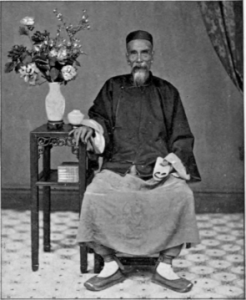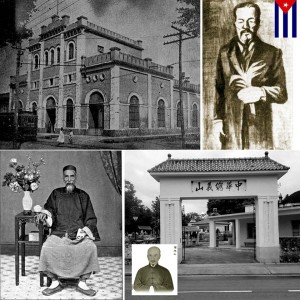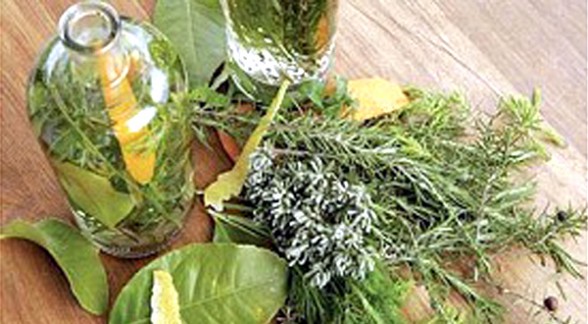CUBAN SLANG: “NOT EVEN THE CHINESE DR. CAN SAVE HIM !”.
There are moments in the history of Cuba when the mix of the real and legendary facts there is no way can’t be detach, as if it were part of the wonderful daily life of the territory, to the extent that an overly rationalistic happen would be unable to understand the intimate fabric of events.
Speak of the famous Cham Bom-BIA (Chang Piang Pon), the Chinese doctor, whose cures were so extraordinary that it has remained in our folklore the sentence of the supreme seriousness of a patient, “Not even the Chinese Dr. can save him..!”».
One of the biographers of this miracle, Herminio Portell-Vila refers to Bom-BIA Cham arrived in Havana in 1858, establishing an inquiry here, which was visited by people from all walks of life. Later lived in Matanzas, with office in Merchants Street corner of San Diego, near the Escoto family residence, and finally moved to Cardenas, spending his last years in it until his mysterious death.
Portell-Vila he paints “tall man, of quick and piercing little eyes slightly oblique, with many long mustaches in the style tartar, long scraggly goatee slope and wide chin and solemn gestures underlining its figurative language and pompous, dressed like Westerners, and at that time it was not conceived in Cuba to the doctor without hat and frock coat, he also wore a baggy with comic seriousness denim coat. ”
Cardenas appeared in the year 1872, settling in a house on Sixth Avenue, near the corner of 12th Street, next to the current fire station, where he had his medicine cabinet.
Cham Bom-bia, if we ignore the pompous ceremonial he used in his office and visits the sick, can be considered, rather than vulgar healer, as a remarkable man of wide culture oriental sciences, which mixed his deep knowledge Cuban flora and Chinese herbalist who was as wise, with Western medical advances.
In Cardenas wonderful cures performed by hospice physicians fame of that city and Havana, restoring many of their customers health, sight, the use of its members.
In the course of his scientific career quack, acted with absolute detachment, charging fees to the rich, and settling for the poor say, “If you pay pa linelo me. If not, do not pay, I siemple gives people poble pa medicine. ” Medicines sometimes the provided kit of particular and other recipes that were released by the Chinese pharmacy on Third Avenue number 211.
Cham Bom-BIA popular win came in Cardenas and throughout the island, becoming, according to Portell-Vila, the high priest of medicine, the same yesterday, today, as well as the popular phrase expresses that on it endures , as quoted above, and there is another variant: “A cure or not that Chinese doctors.”
One morning found dead at Cham Bom-bia, lying on the bed in the house that always lived alone in the North Pearl. He could never clarified the cause of his death, attributing it, some, to suicide, and others to a poison administered by any of his colleagues jealous of his fame.
From him are, in addition to its high reputation into the stratosphere, these verses that apply to all street Mataperros Orientals:
Chino manila,
Cham Bom-biá:
Cinco tomates
Por un reá.
Posters/ElCuriosoParlanchin/InternetPhotos/TheCubanHistory.com
THE CUBAN HISTORY/ HOLLYWOOD.
Arnoldo Varona, Editor.
FRASES CUBANAS: “A ESE NO LO SALVA NI EL MEDICO CHINO..!”
Hay momentos en la historia de Cuba en que se mezclan hechos reales y legendarios de tal modo, que no hay manera de desligarlos, como si lo maravilloso formara parte de la vida cotidiana del territorio, hasta el punto de que una visión demasiado racionalista del acontecer sería incapaz de comprender la íntima urdimbre de los acontecimientos.
Hablaré del famosísimo Cham Bom-biá, (Chang Pon Piang), el Médico Chino, cuyas curaciones fueron tan extraordinarias que de él ha quedado en nuestro folklore la frase ponderativa de la suprema gravedad de un enfermo: «No le salva ni el Médico Chino».
Uno de los biógrafos de este milagrero, Herminio Portell-Vilá, refiere que Cham Bom-biá llegó a La Habana en 1858, estableciendo aquí su consulta, que era visitada por personas de todas las clases sociales. Vivió después en Matanzas, con consultorio en la calle de Mercaderes esquina a San Diego, próxima a la residencia de la familia Escoto; y por último se trasladó a Cárdenas, pasando en ella sus últimos años, hasta su misteriosa muerte.
Portell-Vilá lo pinta «Hombre de elevada estatura, de ojillos vivos y penetrantes algo oblicuos; con luengos bigotes a la usanza tártara, larga perilla rala pendiente del mentón y solemnes y amplios ademanes subrayando su lenguaje figurado y ampuloso; vestía como los occidentales, y en aquella época que no se concebía en Cuba al médico sin chistera y chaqué, él también llevaba con cómica seriedad una holgada levita de dril».
En Cárdenas apareció por el año de 1872, instalándose en una casa de la Sexta Avenida, casi esquina a la calle 12, junto al actual cuartel de bomberos, en la que tenía su botiquín.
Cham Bom-biá, si prescindimos del aparatoso ceremonial que usaba en su consultorio y en las visitas a los enfermos, puede ser considerado, más que como vulgar curandero, como un notable hombre de ciencias de amplia cultura oriental, que mezclaba sus profundos conocimientos en la flora cubana y china, como sabio herbolario que era, con los adelantos médicos occidentales.
En Cárdenas realizó curas maravillosas de enfermos desahuciados por médicos de fama de aquella ciudad y de La Habana, devolviéndoles a muchos de sus clientes la salud, la vista, el uso de sus miembros.
En el ejercicio de su carrera científico-curanderil, actuaba con absoluto desprendimiento, cobrando honorarios a los ricos, y conformándose con decirles a los pobres: «Si tiene linelo paga pa mí. Si no tiene, no paga; yo siemple da la medicina pa gente poble». Las medicinas las proporcionaba unas veces de su botiquín particular, y otras mediante recetas que eran despachadas en la farmacia china de la Tercera Avenida número 211.
Cham Bom-biá llegó a conquistar gran popularidad en Cárdenas y en toda la Isla, convirtiéndose, según afirma Portell-Vilá, en el sumo pontífice de la medicina, lo mismo ayer que hoy, como bien lo expresa la frase popular que sobre él perdura, ya citada más arriba, y de la que existe esta otra variante: «A ése no lo cura ni el Médico Chino».
Una mañana encontraron sin vida a Cham Bom-biá, tendido en el camastro de la casa que siempre habitó solo en la Perla del Norte. Nunca pudo esclarecerse la causa de su muerte, atribuyéndola, unos, a un suicidio, y otros a algún veneno administrado por cualquiera de sus colegas, envidioso de su fama.
De él quedan, además de su reputación elevada a la estratosfera, estos versos que los mataperros callejeros aplican a todos los orientales:
Chino manila,
Cham Bom-biá:
Cinco tomates
Por un reá.
Posters/ElCuriosoParlanchin/InternetPhotos/TheCubanHistory.com
THE CUBAN HISTORY/ HOLLYWOOD.
Arnoldo Varona, Editor






